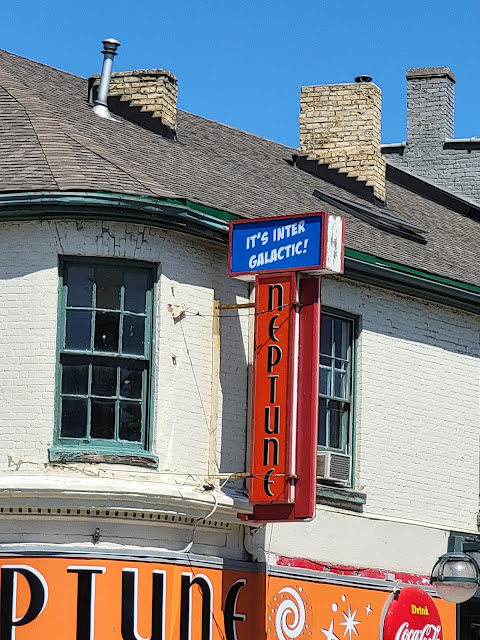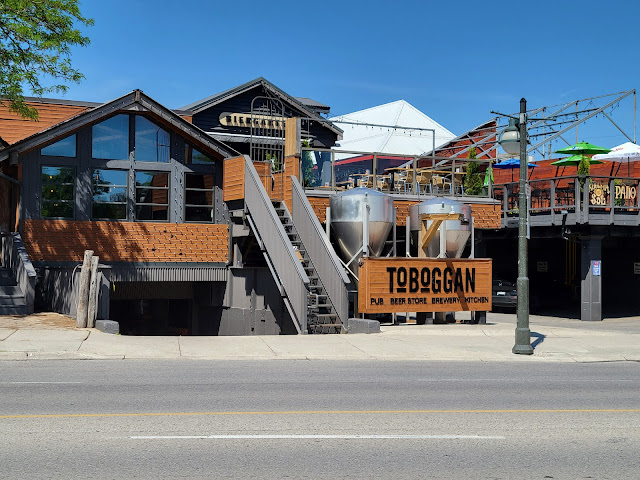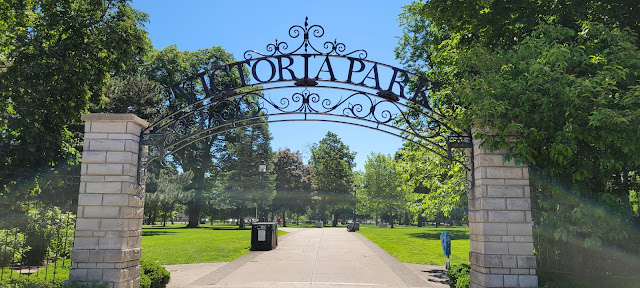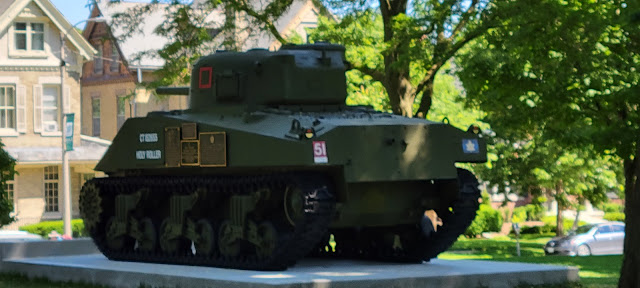Monday June 2022 - London ON
Day 2
Day 3
Weekly recap including meals
Monday we had breakfast at the hotel and headed out around 10:30. The plan was to walk along Richmond, according to the tour guide:
Take a stroll on Richmond Row with its upscale shops like David E. White Clothier and Hangar 9, as well as other chic boutiques, salons and cafés. With wide sidewalks and leafy trees, Richmond Row is also home to some of the most diverse restaurants in the city.It was too early for Spageddy Eddy's to be open, I would love to see the inside.
Standing within the London’s business core the Dominion Public Building is a distinctive example of Modern Classicism. It is a six-storey building with a tall tower emphasizing one end. Built of smooth ashlar limestone, the impression created is of a stepped skyscraper with a long extension to the rear.
The building is distinguished by the strong vertical accent of the multi-storey piers and recessed windows, the polished black granite used for the plinth course, around the entry doors and by the decorative masonry carvings.
The Dominion Public Building is a very good example of the theme of the establishment of a federal presence in communities across Canada; also of the theme of major buildings erected under the Public Works Construction Act of 1934. In an effort to alleviate the worst effects of the Great Depression the Federal Government allocated 40 million dollars to public works so as to generate employment and to stimulate the economy. The Dominion Public Building is one of the more prominent of the 26 buildings erected under this Act.
The grounds of the Cathedral once served as a graveyard for the village of London. Most of the interred and their grave markers were transferred to Woodland Cemetery, which is owned and operated by the Cathedral. Twelve marked graves remain on the Cathedral grounds as reminders of London's early pioneer days.
Yes, London Ontario has a St. Paul's too.
St. Paul's Cathedral is the seat of the Diocese of Huron of the Anglican Church of Canada. It was designed in the Gothic revival style by William Thomas and built between 1844 and 1846, replacing the previous church, which was built in 1834 and burned down in 1844. It is the oldest church in the city.Just a block away is St. Peter's Cathedral Basilica, the seat of the Roman Catholic Diocese.
It was established in1834 and the first church was constructed of logs at the southwest corner of Dufferin Avenue and Richmond Street. Prior to this, a travelling priest visited the area to celebrate Mass for Catholic residents. The church was dedicated to St. Lawrence and could hold 180 people. It was destroyed along with much of the town in the London fire of 11 April 1845.
A larger frame church was built with donated materials and labour, but this church also burned in August 1850. This was replaced by a new St. Lawrence Church constructed of brick. The new church was located at the northeast corner of Dufferin and Richmond, just in front of the present structure.
There was a funeral taking place and we were told to come back after to visit. However, it was locked when we returned.
Neptune's is a 1950s sci-fi diner.
The pink Marble Slab is an ice cream shop.
Brewery.
Joe Kool's.
Santa's House is supposed to move to a permanent location at Covent Garden Market.
Near the bandshell is the Women's Memorial for the victims of the École Polytechnique massacre in Montreal, built in 1994.
Time for some drinks.
John offered to stop here the next day when we had the car.
Perfect spot, by the railway tracks.
Waiting for the train to pass.
Image source as I forget to get a photo of our lunch spot.

The clock faces south. It takes the shape of the top of a traditional barrel cask with the burnt branding of Alexander Keith's and "EST. 1820" at the centre. From the centre, the brown hands extend. There are no numerals.
Walking back along York St. after getting wine at the LCBO. You can tell they are going to be building condos in this area. Whenever they open a liquor store and a new bank branch you know new housing is coming.
The Tecumseh House, west side Richmond St., between York and the C.N.R.(Canadian National Railway) tracks. This hotel was erected in 1856, and for nearly three-quarters of a century was London's biggest hostelry. When the Prince of Wales (Edward VII) visited London in Sept. 1860, he stayed here, and the great ball given on the occasion was held at the rear of the hotel. About 1890. Other famous guests included Sir John A. McDonald, Henry Ford and Louis Riel.
Back to the hotel.







































The churches are particularly eye catching.
ReplyDelete